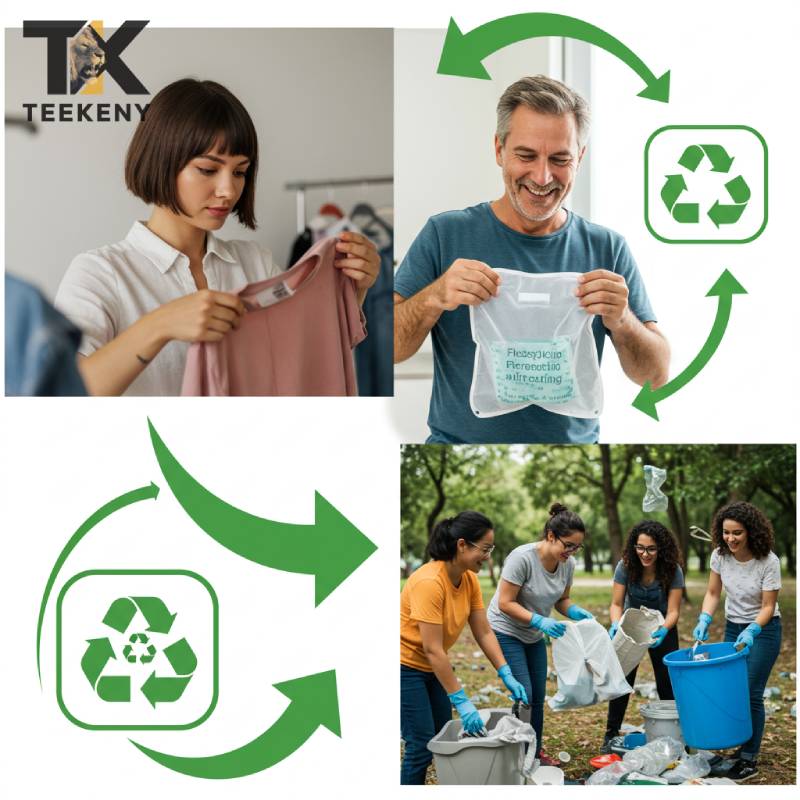Plastic pollution in our oceans has become one of the most pressing environmental challenges of our time. Every year, millions of tons of plastic waste end up in marine ecosystems, threatening wildlife, disrupting food chains, and even impacting human health. One innovative solution to this crisis is recycled polyester (rPET)—a sustainable fabric made from post-consumer plastic waste, primarily sourced from discarded plastic bottles.
This guide explores the role of recycled polyester in reducing plastic pollution, its benefits for the environment, and how consumers and businesses can contribute to a more sustainable future.
Understanding the Problem: Plastic Waste in Our Oceans

The world produces approximately 400 million tons of plastic waste annually, with a significant portion ending up in oceans. According to research, around 8 to 12 million tons of plastic enter marine environments each year. The problem is exacerbated by:
- Single-use plastics: Items like bottles, straws, and packaging materials contribute significantly to ocean pollution.
- Poor waste management: Many coastal regions lack proper recycling infrastructure, leading to plastic leakage into waterways.
- Microplastics: Tiny plastic particles from synthetic fabrics, industrial waste, and degraded plastic objects pollute marine ecosystems and enter the food chain.
Addressing this crisis requires a shift toward sustainable alternatives like recycled polyester, which repurposes plastic waste instead of allowing it to accumulate in landfills and oceans.
What Is Recycled Polyester?

Recycled polyester (rPET) is a synthetic fabric made from post-consumer plastic waste, primarily PET plastic bottles. Instead of producing new polyester from fossil fuels, rPET utilizes existing plastic materials, reducing waste and lowering carbon emissions.
How Is Recycled Polyester Made?
- Collection of plastic waste: Discarded PET bottles are collected from landfills, oceans, and recycling centers.
- Sorting and cleaning: Bottles are cleaned to remove labels, caps, and residues.
- Shredding into flakes: The plastic is shredded into small flakes, which are then melted and transformed into fibers.
- Spinning into yarn: The fibers are processed into polyester yarn, which is then used in textiles.
This process helps divert waste from the environment while creating a durable and functional fabric for clothing, accessories, and home textiles.
Environmental Benefits of Recycled Polyester

Switching to recycled polyester provides several environmental advantages:
Reducing Plastic Waste in Oceans
- Every 1,000 kg of recycled polyester can save up to 60,000 plastic bottles from ending up in landfills or waterways.
- Companies using ocean-reclaimed plastics help clean marine environments and support conservation efforts.
Lowering Carbon Footprint
- Producing rPET requires 59% less energy compared to virgin polyester.
- The process reduces CO₂ emissions by approximately 32%, making it a more eco-friendly option.
Conserving Natural Resources
- Traditional polyester production relies on petroleum, a non-renewable resource.
- rPET reduces dependence on fossil fuels, promoting a more circular economy.
Minimizing Water Usage
- Virgin polyester manufacturing consumes large amounts of water for cooling and dyeing processes.
- rPET production uses significantly less water, helping preserve freshwater sources.
Decreasing Microplastic Pollution
- Although polyester fabrics shed microfibers during washing, using rPET from ocean waste reduces the introduction of new plastic into marine environments.
- Technologies like washing filters and bioengineered fabrics can further minimize microfiber pollution.
Industries Adopting Recycled Polyester

Fashion Industry
- Brands like Patagonia, Adidas, and Nike have embraced rPET to create sustainable clothing.
- The use of recycled polyester in activewear, outerwear, and accessories is growing due to its durability and performance.
Sports and Outdoor Gear
- Companies producing backpacks, shoes, and outdoor jackets increasingly rely on rPET to align with sustainability goals.
- Many soccer teams and marathon events use jerseys made from ocean-reclaimed plastics.
Home Textiles and Furniture
- Recycled polyester is found in curtains, carpets, pillows, and upholstery, offering an eco-friendly alternative to traditional synthetic fabrics.
Automotive and Aerospace Sectors
- Car manufacturers integrate rPET into seat fabrics and interior linings to enhance sustainability efforts.
- Airlines are exploring rPET-based materials for cabin interiors and uniforms.
Challenges and Limitations of Recycled Polyester

While recycled polyester offers numerous benefits, some challenges remain:
Recycling Limitations
- Unlike materials such as glass or metal, polyester can only be recycled a few times before fiber quality degrades.
- Innovative solutions like chemical recycling aim to extend polyester’s lifespan.
Microfiber Shedding
- rPET garments still release microplastics during washing, though filtration systems and fabric treatments can reduce this impact.
Energy Use in Processing
- Although rPET reduces overall energy consumption, the melting and reprocessing stages still require significant energy inputs.
- Transitioning to renewable energy in textile factories can enhance sustainability.
Cost and Availability
- rPET production is currently more expensive than virgin polyester due to processing complexities.
- As demand grows, economies of scale may lower costs and increase accessibility.
How Consumers Can Support Recycled Polyester

Individuals can contribute to a more sustainable future by:
Choosing Sustainable Brands
- Support brands committed to rPET and ethical production.
- Look for certifications like Global Recycled Standard (GRS) and OEKO-TEX.
Washing Clothes Responsibly
- Use washing bags or microfiber filters to reduce plastic shedding.
- Wash in cold water and avoid tumble drying to extend fabric life.
Recycling Plastic Waste
- Properly dispose of plastic bottles to ensure they enter recycling streams.
- Encourage local recycling programs and participate in cleanup initiatives.
Advocating for Sustainable Policies
- Support policies that reduce plastic production and increase recycling infrastructure.
- Encourage brands to adopt circular economy practices in fashion and textiles.
The Future of Recycled Polyester and Sustainability

The textile industry is evolving, with innovations like:
- Chemical Recycling: A technology that breaks down polyester into its raw components, allowing for indefinite recycling.
- Bio-based Polyester: Researchers are developing plant-based alternatives to further reduce reliance on fossil fuels.
- Closed-loop Systems: Brands are creating take-back programs where consumers return old clothing for recycling into new fabrics.
As demand for sustainable fashion and eco-friendly materials grows, recycled polyester will play a crucial role in reducing ocean plastic pollution and promoting a greener future.
Conclusion
Recycled polyester is a powerful solution to the global plastic waste crisis, helping transform discarded plastics into high-performance textiles. By reducing plastic pollution, conserving resources, and lowering carbon emissions, rPET represents a significant step toward a more sustainable and circular economy.
Consumers, brands, and policymakers all have a role to play in supporting recycled polyester initiatives—whether through conscious purchasing, responsible washing, or advocating for greener industry practices. With continued innovation and commitment, we can reduce the impact of plastic waste on our oceans and move toward a cleaner, more sustainable planet.

